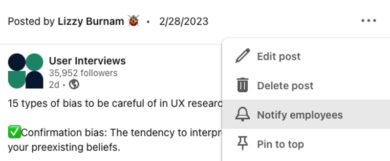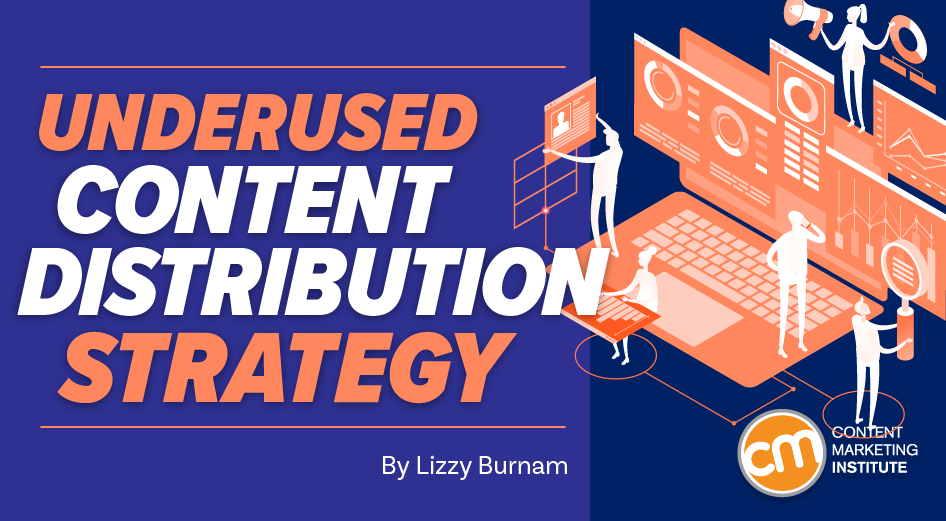Content marketers notoriously never have enough resources.
Many of us work on a one-person content team, doing our best to shoehorn content strategy, creation, distribution, reporting, and (maybe) a lunch break into the always-too-short work week.
Yet, few of us use a low-cost distribution channel that can exponentially increase content reach with little additional work.
That distribution channel? Our colleagues.
Your colleagues are a low-cost distribution channel that can exponentially increase #content reach, says @egburnam via @CMIContent. Click To TweetWhy every content team needs an internal distribution strategy
Internal promotion expands external distribution. When co-workers know what content you publish, why it’s important, and how it applies to their roles, they’re more likely to share it with their networks, clients, and prospects.
That’s not the only benefit. Internal distribution and promotion also can help you:
- Hit content key performance indicators (KPIs) like website sessions and marketing-qualified leads.
- Communicate the value and impact of your work.
- Align the organization’s content messaging and strategy.
- Boost organic distribution via employee advocacy.
- Create hype and momentum on social media.
- Foster a culture of transparency and collaboration.
- Spark new, high-impact ideas for content marketing.
As Dave Gerhardt writes:
Marketing is one of the most misunderstood operations inside of a company and if you aren’t able to control the narrative, show what you’re working on, and articulate why it matters, you’ll end up with the status quo today: ‘My company has no idea what marketing should be doing.’
As a content marketing manager at User Interviews, I heavily promote the content team’s work to the rest of the organization. This encourages engagement and employee advocacy, drives our brand narrative across the organization, and keeps everyone in the know about our work.
Promote the content team’s work to the rest of the organization to encourage engagement and advocacy, says @egburnam via @CMIContent Click To TweetInternal distribution tactics
I’ve used these tactics, so I know they work. I’ve seen an increase in employee engagement on social media and a backlog of content ideas from other teams. I also started tracking a new metric for LinkedIn engagement.
1. Internal newsletters
Almost 70% of B2B marketers use email newsletters to distribute content to prospects and customers. So why not use the same strategy to distribute content to your brand’s employees?
I send a monthly company-wide email highlighting the following:
- Content wins and milestones from the previous month
- Each newly published content asset with summaries and tips for sharing
- Content planned for the upcoming month
I send it monthly because that’s doable, given my bandwidth, and I use other tactics to keep colleagues in the loop throughout the month. Pick the cadence that works best for you.
2. Internal blogs and documents
Internal documentation is a classic strategy because it works.
You can use any one of a number of tools to house the documents. Notion, Confluence, and Asana are popular options, but a well-organized Google Drive folder works, too.
Some of the information to include in these internally accessible documents:
- Company, team, and industry insights
- Announcements like new content franchises or viral posts
- Planned future content on a shared, easily-accessible content calendar
- Tips for effective writing, social engagement, and other content-related how-tos
- Templates for content-related documents like project plans and briefs
- Processes for sharing content topics and ideas
- Locations of videos, reports, infographics, and other high-impact content
3. Content repositories
Have you ever been bombarded with questions like these?
- “Do we have any articles about X?”
- “Hey, I know we wrote about Y a while back, but I can’t find it on the website.”
- “We should create some content about [topic you’ve already written about]. Why haven’t we covered that already?”
They probably reinforce what you already know – your external site’s search functionality doesn’t work well. Or external-facing content doesn’t contain the tags and filters that internal teams use, such as funnel stage, user segments, and performance metrics.
An internal content repository can help solve those challenges. You can create content repositories through CMS platforms, documentation tools like Notion, or (less easily) with a spreadsheet. By offering an organized, filterable, accessible repository for high-performing content, you enable employees to find, share, and use content without having to ping you to find it.
Before you create the repository, meet with the people who are most likely to use it – usually other members of marketing, sales, and success teams – and ask what fields would be helpful to them. You might consider including the following:
- Topic
- Date published
- Author
- Content type
- Funnel stage
- Audience
- Related product or feature
- Recognition as editor’s choice for topical or high-performing pieces
- Summary
- Pull quotes or statistics
4. LinkedIn’s notify-employees feature
Did you know about this feature? I didn’t know about “notify employees” until I worked on growing LinkedIn engagement at my current company.
If you’re an admin of your company page, you can click the three dots on the top-right corner of any post and click the “notify employees” button as this screenshot shows:

All employees who have identified your company as their employer get pinged when the company publishes a new post. When they like or share that content, your organic reach grows.
TIP: You can only use this button once every 24 hours. If you post multiple times a day, choose wisely.
#Content distribution tip: @LinkedIn company page admins have a “Notify employees” menu option to alert colleagues of newly posted content, says @egburnam via @CMIContent. Click To Tweet5. Internal research
Internal research can help you understand how different teams use and discover content (or if they don’t), their goals and priorities, and how content can help them achieve those goals.
I recently interviewed folks from the revenue team. It resulted in a massive bank of content ideas and gave me a chance to shed light on resources and opportunities previously unknown to the revenue team. Among the questions I asked:
- What are the common customer/prospect pain points you deal with at your stage of the sales process?
- What are the common questions you get from customers/prospects? How do you answer them?
- What are the common challenges and objections in getting customers/prospects to move forward?
- How do you use content in your day-to-day life?
- Can you name a few pieces of content you regularly reference or that stood out? Why do they interest you?
- How have you used content at other employers? When was it most useful?
- Walk me through your process for sharing content with customers, starting with the moment you identify an opportunity to share.
- Describe a time you searched for content but couldn’t find it.
- Where do you discover new content we’ve published?
- If you had a magic wand, what would you wish for to make your job easier?
6. Slack updates and channels
In a remote-first world, Slack functions as a digital “office” for many companies, making it a great place to get people’s attention for bulletin board-type announcements.
I recommend creating three different channels for internal distribution:
- #New-content or #blog-updates – Notify the team whenever new content is published. You can automate this with the RSS Slack app integration.
- #Hype or #social – Notify the team of new social media posts. Add context about what’s in it for the employee so they’re more likely to like, share, and engage with each post.
- #Enablement – Share enablement content like white papers, infographics, messaging guides, and other role-specific resources. Call out different teams specifically and tailor the message to each team’s priorities.
7. Show-and-tell meetings
Pelting your team with emails and Slack updates can get a little old. Hosting company-wide show-and-tell meetings can help you convey the value, strategy, and impact of the content marketing work in a more engaging format.
Seeing and hearing your excitement as you talk about the work can make a massive difference in employee engagement, especially in remote-first companies. These gatherings also give colleagues a chance to ask questions and provide feedback.
Reserve these meetings for big announcements or interactive sessions, such as:
- Heavy-lifting content initiatives
- Internal employee engagement contests
- Topic brainstorming activities
8. Recognition and incentives
When teammates share and engage with the content, don’t let it go unnoticed. We use Bonusly, an employee rewards platform, for our most active employee advocates.
In the absence of monetary incentives, a simple public thank-you can suffice. If you have any data related to the impact of employee advocacy, such as an increase in LinkedIn engagement rates or data from Google Analytics, share it to let folks know the tangible impact they have.
9. Quotes and guest articles
Finally, get your co-workers involved in the content creation process. Encourage them to write a blog article, speak on the podcast, join webinars, or get involved in another way.
When they create the content, they’re more likely to promote it on their networks. It helps build their personal brands while uplifting your company’s brand too.
If colleagues don’t have the time to get that involved, incorporate their input by getting brief quotes to use in your content.
Decide these three things first
Before you get started with your internal content strategy, determine these three elements:
- Cadence: The ideal frequency for these tactics depends on your brand’s culture and employee preferences. Some may appreciate weekly tips, updates, and announcements from the content team, while others may find that frequency overwhelming. Explore and find the sweet spot for your organization.
- Audience: Across your organization, multiple internal personas – sales, service, product, leadership – exist. Their needs, preferences, and use cases may differ. Tailor your distribution to cater to each team’s interests.
- Feedback: A few weeks or months after the internal distribution program launches, survey the employees. Has it been useful to them? What would improve its utility? Incorporate their feedback as you update your internal strategy.
Revisit these three elements any time you’re getting constructive feedback or noticing a decline in employee engagement with content.
Amplify your content within your brand
Too often, marketers focus on publishing and promoting content without considering its utility for the rest of their colleagues. But when you effectively distribute and promote content to your internal teams, you:
- Keep them informed about relevant industry news and best practices.
- Showcase your brand’s subject matter expertise and builds employees’ credibility.
- Drive a consistent brand narrative across teams, creating strategic alignment.
- Demonstrate the growth and momentum of your brand’s online presence.
As a content marketer, remember your other audience – your co-workers – and ensure your content distribution reaches them too.
All tools mentioned in this article are identified by the author. If you’d like to suggest a tool, please add it in the comments.
HANDPICKED RELATED CONTENT:
Cover image by Joseph Kalinowski/Content Marketing Institute

